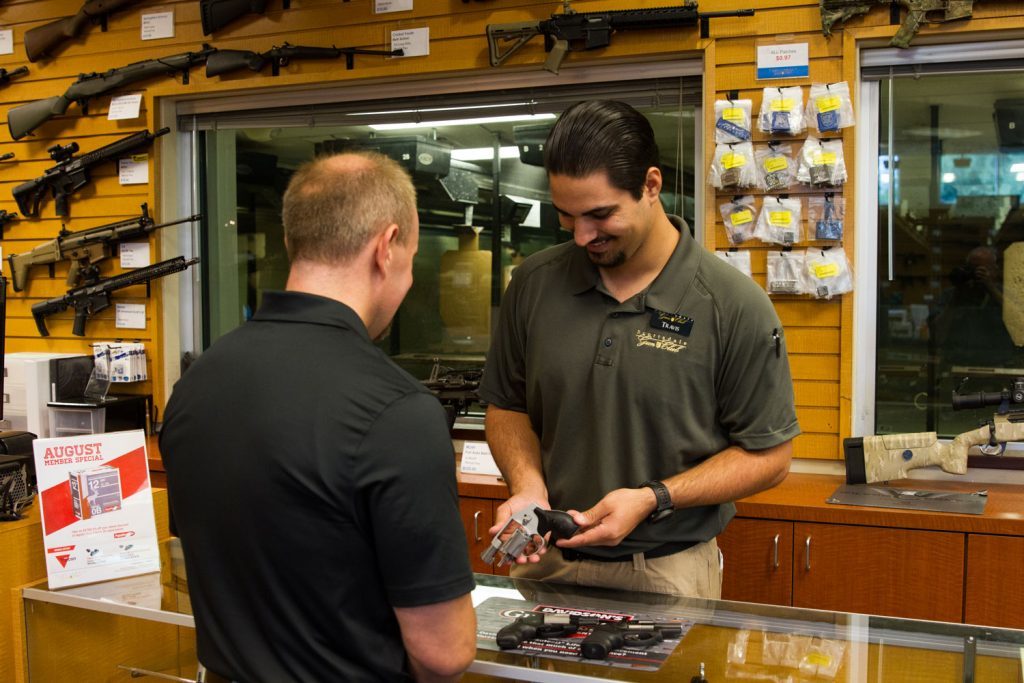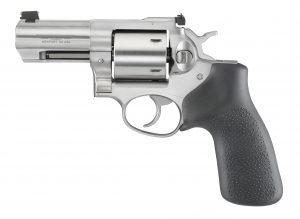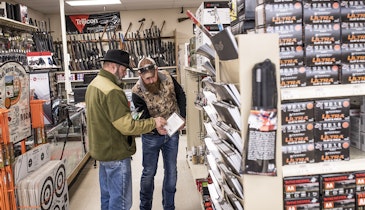“If you have them, they will sell.” This is the opinion of Paul Sherman, the purchasing manager for the Scottsdale Gun Club, a large retailer with an indoor range and training facilities located in Scottsdale, Arizona. His comment regarding the sale of revolvers is a reflection of the opinion of everyone interviewed for this article, confirming that revolvers are, indeed, still sellable.
Production
In 2014, the last year for which production numbers are publicly available, Smith & Wesson produced nearly 1.2 million handguns, and Ruger produced just over 1 million. Semi-auto production was much greater than revolver production, yet about 23 percent of all S&W handgun production and about 28 percent of Ruger’s was revolvers. That’s approximately 268,000 revolvers for Smith & Wesson and about 281,000 for Ruger. Yes, Ruger actually made more revolvers than Smith & Wesson that year.
Ken Jorgensen, the director of media relations and spokesman for Ruger, said the company is on track to make more than 2 million guns in 2016, a significant increase over the previous year’s production. And revolvers will be a part of that increase. Clearly, Ruger revolvers are selling.
“Ruger has a great all around line. There’s something for everyone,” Jorgensen said.
He went on to say that the LCR is very popular and comes in .38 Special, 9mm and .327 Magnum. There are models with hammers and without, and various barrel lengths are manufactured. Ruger is especially proud of the LCR’s smooth trigger pull, and all of these attributes make it a strong seller.
New Players
Some companies see the revolver market as being strong enough to support entry. One company that has not previously made revolvers announced in late 2015 that it would offer a self-defense revolver chambered in .357 Magnum. Kimber’s K6S revolver was a surprise to most since the company has become well-known for producing semi-automatic handguns, particularly 1911s.
Rachel Vandevoort, the trade relations manager for Kimber Mfg., Inc., said that while Kimber had no statistics or market trend data to support the introduction of a revolver, it did so based on a belief that the revolver would be successful.
That’s a big bet on a feeling, but Kimber has been a successful company and has made a lot of correct decisions in the past. Vandevoort went on to say that the K6S was designed for the customer who wants an all-metal handgun with good ergonomics in a small size for discreet carry that offers a higher round count than many of the other small revolvers offered today. With six rounds in a cylinder that has flattened sides, it reduces the size of the cylinder to lessen printing through garments while also carrying a larger payload than its J-frame competitors from Smith & Wesson.
Another company that has made the leap of faith by introducing a line of revolvers is Nighthawk Custom of Berryville, Arkansas, that is best known for its custom-manufactured high-end 1911s. It recently announced that it will be importing, modifying and selling Korth revolvers. Korth is a German firearms manufacturer that also has a reputation for producing very high-quality guns (for a price).
Travis Noteboom, the vice president of sales and marketing for Nighthawk, said the decision to handle Korth revolvers was based on nothing more than a feeling that they would sell. According to Noteboom, Nighthawk will be addressing a niche market for high-end revolvers and believes that the revolver market will always be around.

A helpful and knowledgeable sales staff is key to helping customers find the right fun for self-defense. That gun is often a revolver.
Other Manufacturers
There is evidence from other manufacturers to support Kimber’s and Nighthawk’s bold move. Crimson Trace, for example, sells laser-aiming devices for specific revolver; its sales numbers for which offer a way to track the strength of the revolver market.
According to Michael Faw, a Crimson Trace spokesman, “sales trends in all laser categories are up,” which includes revolvers.
“Our laser sights will fit on a wide assortment of Ruger, Smith & Wesson, Taurus and other revolvers, and we’ve announced we will soon be releasing a Lasergrip for the new Kimber revolver,” Faw said.
Additionally, Crimson Trace has enough faith in the revolver market that it now makes a grip without a light or laser for the Kimber.
Another company that sells accessories for guns that are specific to the particular make and model is Galco Gunleather. Even though the handgun market has shifted demand in favor of semi-automatics, Galco reported that holsters for revolvers continue to sell well. Holsters designed for pocket or ankle carry and belly-band rigs seem to be the most popular, indicating that smaller revolvers that are easy to carry discreetly are selling.
“The most popular revolvers for concealed carry, unsurprisingly, are small-frame guns like the S&W J-frame, Ruger LCR and the various Taurus small frames,” said Mike Barham, Galco’s spokesman. “It’s a little tough to narrow it down to particular guns, simply because holsters for small-frame revolvers tend to fit multiple guns from a few different manufacturers.”
Nevertheless, Barham reports that Galco’s Carry Lite line is a big seller, and a surprising number of shoulder holsters are also sold. To emphasize the popularity of revolvers for self-defense, Barham revealed that the company still gets requests for holsters to fit old Colt D-frames, which have been out of production for many years. However, Galco can accommodate those requests.
Retail View
The manufacturers who contacted by Tactical Retailer are in agreement that the revolver market is alive and well and will likely remain so for quite some time. But how do retailers at the end of the supply chain view the revolver market?
Located in Mesa, Arizona, the Pistol Parlour carries a wide inventory of firearms, but specifically caters to women who are looking for a self-defense gun. A feature of revolvers that appeals to many customers, both male and female, is the ease of operation. Revolvers are simple to operate and do not have the controls most often found on a semi-automatic.
Clyde Helquist, the owner of the Pistol Parlour, said most customers come into the store looking for help in choosing a self-defense gun. His staff takes the time to help the customer find the right gun by asking questions and listening to responses. They have the customer hold various guns and if he or she cannot manipulate the slide, a revolver is usually a good option.
While sales of semi-automatics are still much greater than the sales of revolvers, Helquist estimates that revolver sales are about 5 percent of his handgun sales, and the market for revolvers is large enough for him to carry a good assortment. He has approximately 15 to 20 compact revolver models in stock. Smith & Wesson models are the best sellers followed by the Rugers, especially the LCR. Helquist said he attributes the popularity of the LCR to the fact it is offered in several calibers including .22 Magnum and 9mm.
According to Sherman, carry revolvers sell well, and revolver sales are actually trending up at Scottsdale Gun Club. Sherman also said that the .38 Special is the most popular revolver cartridge with Smith & Wesson J-frame models being the biggest seller. The Ruger LCR is the second most popular, and revolvers remain in SGC’s rental fleet where they are shot frequently on the store’s indoor range.
Why are revolvers still popular? The shooter/firearm interface is simple. Basically, just point the gun and pull the trigger. There are no safeties or slide catches to deal with, and one does not have to worry about a magazine release or a separate magazine to manage ammunition. It is also easy to see at a glance whether or not the gun is loaded, unlike a semi-automatic where loading and unloading involves certain steps that must be followed in a specific order to assure the gun is in the condition wanted. If someone has little training or is not willing to get proper training to operate a semi-automatic and practice doing so on a regular basis, they usually gravitate to the revolver.
When asked who buys revolvers, Sherman broke the market down into two categories. He estimated that approximately 30 percent of his revolver buyers are experienced, often older shooters who have a history with revolvers and understand revolver virtues and limitations. About 70 percent of buyers are new shooters who are looking for a simple to operate gun or who have a difficult time operating the slide on a semi-automatic.
Although the revolver market may not be as large as the one for semi-automatic handguns, it is still a good bet for retailer profits.
New Ruger GP100 .44 Special
For 2017, Ruger is releasing its GP100 chambered in .44 Special. This 5-shot double-action revolver is all-stainless steel and has a three-inch barrel. At 36 ounces, Ruger calls it the “perfect balance of weight and size for the .44 Special.”
I spoke briefly with Ruger’s Mark Gurney who said the gun is ideal for customers who are recoil sensitive but who still want potent big bore performance without having to carry around a massive gun. “It’s heavy enough that you can shoot it forever and at the end of the day it’s still a GP that will stand up and you can pass on to your grandchildren,” says Gurney.
In addition to the mild recoil, Gurney emphasized that the new gun’s size is very carry friendly. “It’s not a .44 Magnum-size gun that you put .44 Specials in,” he says.
Triple-locking cylinder
- Hogue Monogrip
- Green fiber optic front sight
- Adjustable rear sight
- 8 1/2 inches long
- 36 ounces
- MSRP $829
Not CA approved. Not MA approved and certified.







